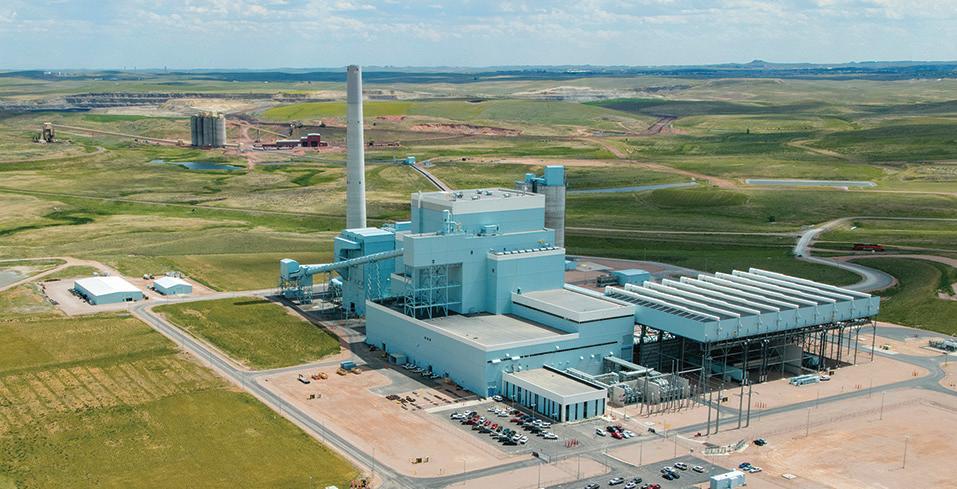
3 minute read
Capturing Carbon
By Katherine Loving and Paul Wesslund
Providing reliable, affordable electricity is a priority for publicly owned utilities. Co-ops, PUDs and municipals continue to incorporate additional energy generated from renewable sources. Until these technologies fully mature, fossil fuels remain a part of our overall generation mix to ensure power reliability.
As the United States moves forward with carbon reduction goals, utilities are looking for ways to provide clean energy and offset the carbon generated during power production. Capturing carbon emissions—or greenhouse gases—at their source is one of those approaches.
Understanding some of the terminology associated with this complex process can shed light on this unique way of managing greenhouse gases.
You’ve likely heard the term net zero. This means you don’t increase the amount of carbon dioxide in the atmosphere. Essentially, any greenhouse gas you emit is reduced in some other way.

Net zero typically takes the form of a nation or commercial business setting a goal to offset carbon emissions it produces from burning coal, oil or natural gas. Those offsets can be as simple as planting a lot of trees that convert carbon dioxide to oxygen as part of their photosynthesis process. It can be as complex as building high-tech equipment to remove greenhouse gases before they reach the air or even after they are emitted.
Net zero was first widely discussed about 10 years ago as countries met to negotiate the Paris Climate Agreement and determine language to discuss reducing greenhouse gas emissions. Since then, nearly 500 nations, cities and states—and more than 700 companies—have set goals of reaching net zero within the next 30 years.
Another term for net zero is carbon neutral. In 2020, Microsoft Corp. announced a goal of going carbon negative, meaning it would remove more greenhouse gas from the air than it emits.
Carbon capture, utilization and storage is one tool for reaching net zero. In the past, it was simply called “carbon capture,” but is now often referred to as CCUS.


CCUS involves a series of steps that removes carbon dioxide from its original source to prevent it from reaching the atmosphere. During the capture step, CO2 is removed either before or after combustion.


Post-combustion capture is the most common method used at existing power plants. After electricity is generated, the CO2 is removed from the gas mixture found in a plant’s flue.
In precombustion capture, the fuel sources are heated with pure oxygen—or steam and oxygen—to release CO2
Once captured, the CO2 is transported to its next destination. Typically, CO2 moves as compressed gas in pipelines, but it can also be transported by tanker trucks or ships. Captured CO2 can be injected into

New and Emerging CO2 Technologies
Despite several hurdles, carbon capture is seen as an important technology in reducing emissions.
In 2015, XPRIZE—a technological development competition—kicked off with an aim to award $20 million to develop new and emerging technologies that use CO2. The competition was based on how much CO2 was converted and the economic feasibility of the project.
The winning project was a carbon-negative concrete created by a team of UCLA researchers called CarbonBuilt.
The research team conducted tests at Basin Electric Power Cooperative’s Integrated Test Center in Wyoming to turn flue gases and fly ash into carbon-negative concrete. The process reduces the carbon emissions of concrete production and traps additional carbon long-term within the final product.

geological formations or recycled for other uses.
Research on how to recycle CO2 is ongoing, but established uses include using the gas in enhanced oil recovery, growing fish food from lab-grown bacteria that feed on CO2 and creating carbon-negative concrete or other carbon-based materials.
One appeal of carbon capture is the abundance of underground natural storage locations, such as deep aquifers, porous rock and unproductive coal mines.
The U.S. Geological Service estimates the United States has the potential to store 3,000 metric gigatons of CO2, the equivalent of five centuries worth of emissions.
Carbon dioxide removal doesn’t center on keeping greenhouse gas from entering the atmosphere, but rather taking it out of the air. It’s also often referred to as direct air capture. Some businesses are already using CO2 from direct air capture for things such as fertilizer production.
The federal government made carbon capture a funding priority in 2022. The Infrastructure Investment and Jobs Act provides $927 million for large, commercial-scale pilot projects as well as $3.5 billion for six demonstration projects at coal and natural gas plants.
The Slowing CO2 and Lowering Emissions Act was introduced in 2021 and provides funding to overcome expansion barriers. The act aims to reduce costs by financing scaling projects for pipeline infrastructure, creating regional storage infrastructure and providing grants for creating products derived from large-scale capture.
Capturing carbon is an important tool in reducing CO2 emissions generated from fossil fuel use. As this emerging technology is deployed on a larger scale, the future of carbon capture will continue to be promising.










